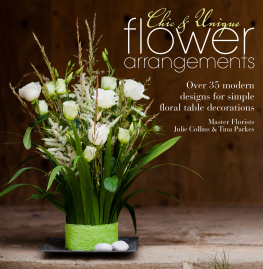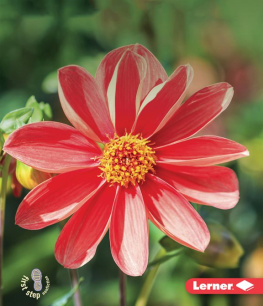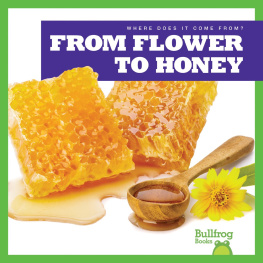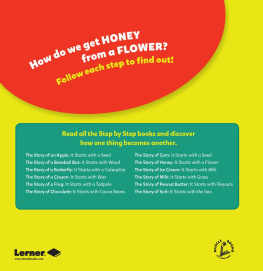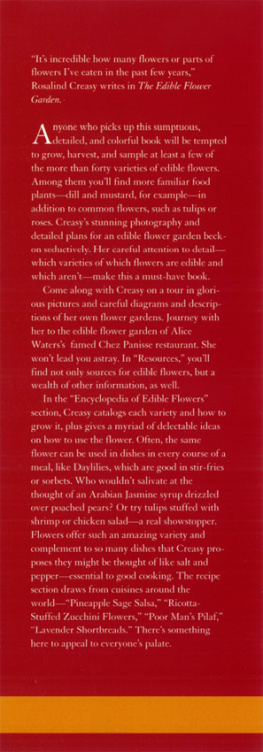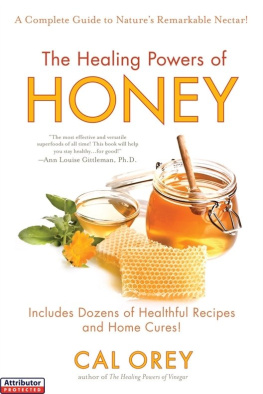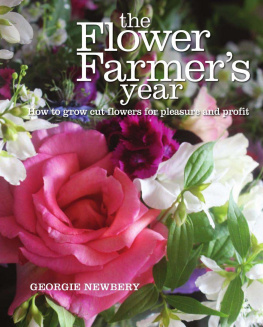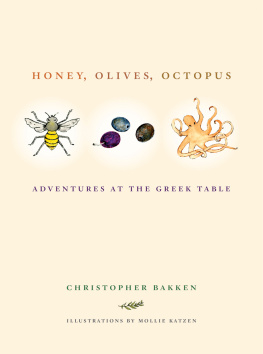Rosenbaum - Honey: from flower to table
Here you can read online Rosenbaum - Honey: from flower to table full text of the book (entire story) in english for free. Download pdf and epub, get meaning, cover and reviews about this ebook. City: San Francisco, year: 2002, publisher: Chronicle Books LLC, genre: Home and family. Description of the work, (preface) as well as reviews are available. Best literature library LitArk.com created for fans of good reading and offers a wide selection of genres:
Romance novel
Science fiction
Adventure
Detective
Science
History
Home and family
Prose
Art
Politics
Computer
Non-fiction
Religion
Business
Children
Humor
Choose a favorite category and find really read worthwhile books. Enjoy immersion in the world of imagination, feel the emotions of the characters or learn something new for yourself, make an fascinating discovery.

- Book:Honey: from flower to table
- Author:
- Publisher:Chronicle Books LLC
- Genre:
- Year:2002
- City:San Francisco
- Rating:3 / 5
- Favourites:Add to favourites
- Your mark:
- 60
- 1
- 2
- 3
- 4
- 5
Honey: from flower to table: summary, description and annotation
We offer to read an annotation, description, summary or preface (depends on what the author of the book "Honey: from flower to table" wrote himself). If you haven't found the necessary information about the book — write in the comments, we will try to find it.
Honey: from flower to table — read online for free the complete book (whole text) full work
Below is the text of the book, divided by pages. System saving the place of the last page read, allows you to conveniently read the book "Honey: from flower to table" online for free, without having to search again every time where you left off. Put a bookmark, and you can go to the page where you finished reading at any time.
Font size:
Interval:
Bookmark:



Text copyright 2002 by Stephanie Rosenbaum
Photographs copyright 2002 by Caroline Kopp
All rights reserved.
No part of this book may be reproduced in any form
without written permission from the publisher.
Library of Congress Cataloging-in-Publication Data available.
ISBN: 978-0-8118-3238-0 (hc)
ISBN 978-1-4521-3451-2 (epub)
Designed by Efrat Rafaeli
Prop styling by Carol Hacker
Food and craft styling by Clair Hadley
The photographer would like to thank beekeepers Spencer and Helene Marshall
of Marshalls Farm, and Hector Alvarez of Hectors Apiaries Services for their time and generosity.
Many thanks to Tom Chester, Irene Davidson, Joe Guliane, and Yvonne Johnson at the
San Francisco Beekeepers Association. Thanks also to Helie Robertson for her lovely garden,
and Karen and Tim Bates from The Apple Farm for their beautiful orchard.
Chronicle Books LLC
680 Second Street, San Francisco, California 94107
www.chroniclebooks.com

Drano is a registered trademark of The Drackett Chemical Company. Epi-Pen is a registered trademark of EM Industries, Incorporated. Krispy Kreme is a registered trademark of HDN Corporation. Manischewitz is a registered trademark of The B. Manischewitz Company, LLC. Nutella is a registered trademark of Ferrero S.P.A.
This book is intended as a practical guide to the crafting and cooking with honey. As with any craft or cooking project, it is important that all the instructions are followed carefully, as failure to do so could result in injury. Every effort has been made to present the information in this book in a clear, complete, and accurate manner, however not every situation can be anticipated and there can be no substitute for common sense. Check product labels, for example, to make sure that the materials you use are safe and nontoxic. Be careful when handling dangerous objects. The authors and Chronicle Books disclaim any and all liability resulting from injuries or damage caused during the production or use of the craft discussed in this book.

Many thanks to Flo Braker, Elizabeth Faulkner, Fran Gage, David Lebowitz, Mani Niall, James Ormsby, and Tori Ritchie for their advice, culinary expertise, and honey lore. Beekeepers Tom Chester and Robert MacKimmie, along with others from the San Francisco Beekeepers Association and the staff of the San Francisco League of Urban Gardeners, provided a wealth of information about getting started with bees. Many thanks to Helene and Spencer Marshall of Marshalls Farm for sharing their passion for Bay Area honey, and to the National Honey Board for all their useful information.
I would like to thank my editor at Chronicle Books, Mikyla Bruder, for her patience, support, and great ideas, and for the careful work of assistant editor Jodi Davis, copy editor Deborah Bruce, and design coordinator Azi Rad. I am indebted to designer Efrat Rafaeli and photographer Caroline Kopp for their beautiful work on this book.
My personal thanks also go to Paige Rogers for bringing me honey from around the globe; to Charlotte Rogers Melrose for her recipe-testing assistance; to Jennifer Joseph for sharing challah, advice, and trips to farmers markets; to Brian Bouldrey for his useful information on Catholicism and the Masons; and to Joy Connolly at Stanford University for Greek and Roman honey customs.
To my mother, Leslie Faulds, for her unstinting love, encouragement, and honey challah recipes, and to my father, Jack Rosenbaum, for sharing his lifelong love of food and writing.
And to Eric, for making my life so sweet.
I have gathered my myrrh with my spice;
I have eaten my honeycomb with my honey...
Song of Songs

The Owl and the Pussycat sailed with it. John the Baptist lived on it. Alexander the Great was buried in it. Philosophers, poets, and popes have exalted it. And a certain chubby bear of very little brain was tempted into many sticky situations by the promise of a jar of it. Magically created by bees out of the nectar of flowers; food for gods, saints, peasants, and kings, honey has occupied a central place in culinary and cultural history for thousands of years. Would the Israelites have made it through forty years in the desert on the promise of a land awash only in milk?
What would a wedding be without a honeymoon? Or a hot biscuit without a voluptuous golden puddle oozing out of every buttery bite? Honey can turn lemons into lemonade, sweeten a cup of tea, soothe a sore throat, cure hay fever, purify a wound, energize a sprinter, and keep a cake moist for days. (And preserve a severed head, but thats another story.) Rich in metaphor, the story of honey is a fascinating one, spanning centuries and dipping into myth, religion, science, poetry, and literature.
Freshly broken from the hive, a chunk of new honeycomb is ripe with all the intoxicating sweetness of a summer day. Veiled in this fragile filigree of wax is the essence of sunshine, golden and limpid, tasting of grassy meadows, mountain wildflowers, lavishly blooming orange trees, or scrubby desert weeds. Honey, even more than wine, is a reflection of place. If the process of grape to glass is alchemy, then the trail from blossom to bottle is one of reflection. The nectar collected by the bee is the spirit and sap of the plant, its sweetest juice. Honey is the flower transmuted, its scent and beauty transformed into aroma and taste.
Authentic, unadulterated, and pure, honey is the only sweetener in nature that can be eaten just as it comes. For bees, the history of honey stretches back over millions of years, as does their intensely social way of living. The production of the hexagonal honeycomb; the three-tier community of queen, drones, and workers; the transformation of flower nectar into honeyall these were in place long before even our most ancient records. Yet anyone with curiosity, a backyard, and a modicum of equipment can tap into the wealth of this fertile tradition. In fact, with so much of the population of wild bees decimated by loss of habitat, pesticides, and a deadly, widespread epidemic of varroa mites, keeping bees is not only fun and productive but ecologically sound. And just as the happiest gardeners are those who let the plants needs dictate the style of the garden, keeping bees successfully is all about letting the bees teach you what they require. No matter how much honey, beeswax, pollen, propolis, and royal jelly a beekeeper reaps from his or her hives, its the bees that really know how a beehive should be run. As Ozark beekeeper Sue Hubbell notes in her apiary journal, A Book of Bees, The only time I ever believed that I knew all there was to know about beekeeping was the first year I was keeping them. Every year since, Ive known less and less and have accepted the humbling truth that bees know more about making honey than I do.
From across the United States and around the world, a growing interest in artisanal honeys has revived the ancient art of small-scale beekeeping. While commercial blends of clover and wildflower honey are reliable and easy to find in any supermarket, curious honey lovers can now find dozens of exotic honeys for sale, from creamy, snow-white Hawaiian honey to teak-colored Italian chestnut honey. Sage and mesquite honeys are prized in the American West, as is tupelo honey in the South, buckwheat in the Midwest, blueberry and cranberry in the Northeast, and eucalyptus, manzanita, and star thistle along the Pacific coast. Like fine wine or freshly pressed olive oil, honey reflects the taste of its source, and each harvest is unique.
Next pageFont size:
Interval:
Bookmark:
Similar books «Honey: from flower to table»
Look at similar books to Honey: from flower to table. We have selected literature similar in name and meaning in the hope of providing readers with more options to find new, interesting, not yet read works.
Discussion, reviews of the book Honey: from flower to table and just readers' own opinions. Leave your comments, write what you think about the work, its meaning or the main characters. Specify what exactly you liked and what you didn't like, and why you think so.





